 3D Fit Spline
3D Fit Spline
![]()
![]()
![]()
Create a 3D fit spline through a series of vertices. Creates a curve which is listed in the Parts list under Curves.
A 3-dimensional fit spline fits a curvature continuous spline between selected sketch points, endpoints of other curves, vertices of parts, or a selection of tangential edges or curves. Use it to create paths for routing, bridging entities together, paths or guides for sweep or loft features, or complex profile creation.
To create a 3-dimensional fit spline, select the feature from the Feature toolbar. To create a spline from vertices, select the desired points in the order you want the spline to follow. Similarly, to create a spline from edges or curves, switch the tab to Edges and select a combination of edges and/or tangential curves. If you need to reorder the selection, click the Reorder items option and drag the item with the grip handle. When finished, select Done to finish reordering.
There are several additional options available when defining a 3D fit spline by vertices: If the spline should be closed, check Closed spline. This option loops the spline back to the starting point. When creating an open spline, define the spline's start or end direction. This selection defines the tangency between the selected entity and the start or end.
Several different entities may be used to define the direction, including edges of parts or surfaces, other curves, sketch entities, planes, or Mate connectors. Toggle the Opposite direction arrow to flip the tangency direction. The magnitude is a scaling factor applied to the calculation that further defines the shape of the curve.
If the start or end of the spline should match the curvature of the selected direction, check the respective Match curvature at start or end. If no start or end direction is selected, the start or end of the spline matches the position of the first and last selected points or vertices.
Both vertex and edge-controlled splines can be approximated. Check Approximate to simplify the spline. Set the Target degree, Maximum number of control points, and Tolerance. Check Keep start derivative and Keep end derivative to preserve the spline’s tangency at both ends. Check Show deviation to view the maximum deviation between the original and reapproximated splines. The Approximate option displays the original spline in yellow and the new approximated spline in magenta.
Once the selected options are chosen, accept the feature. As soon as this is done, a curve is added to the curves list. Use the hide/show functionality in the curves list to hide or show a curve created from a 3-dimensional fit spline.
- Click
 .
.
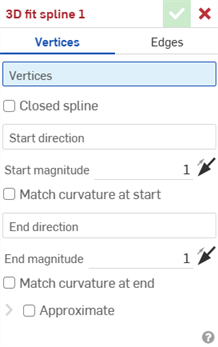
- Click to select whether to use vertices, or edges at the top of the dialog.
- For splines using vertices:
- Click to select vertices along which to create the 3D fit spline.
- Optionally, check the box to create a closed spline.
- If the spline is not closed, you have the option to click a line or a Mate connector (implicit or explicit) to select a Start direction.
- Enter a value or click and drag the directional arrow in the graphics area to adjust the Start magnitude.
- Optionally, click to select Match curvature at start to match the curvature of the edge or face selected as the start direction.
- Optionally, click a line or Mate connector (implicit or explicit) to select an end direction.
- Enter a value or click and drag the directional arrow in the graphics area to adjust the End magnitude.
- Optionally, click to select Match curvature at end to match the curvature of the edge or face selected as the end direction.
- For splines using edges, click to select tangentially continuous edges with which to create the 3D fit spline.
- For splines using vertices:
-
Complex curves can be reapproximated to create simpler curves. Check Approximate to open options to reapproximate the curve. The original curve is displayed in orange, and the new approximated curve is displayed in magenta.
- Target degree - Enter the target curve degree for the selected curve.
- Maximum control points - Enter the maximum number of control points allowed for the selected curve.
- Tolerance - Tolerance of the selected curve, as a length measurement. Enter the tolerance value.
- Keep start derivative - Check to keep tangency at the beginning of the selected curve.
- Keep end derivative - Check to keep tangency at the ending of the selected curve.
- Show deviation - Check to view the maximum deviation between the original curve and the reapproximated curve.
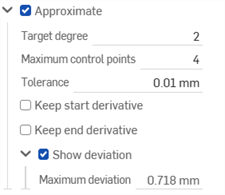
-
Click
 .
.
A curve is created, listed under Curves in the Parts list. You are not able to show/hide the 3D Fit Spline feature; use the show/hide functionality in the Curves (Parts) list instead.
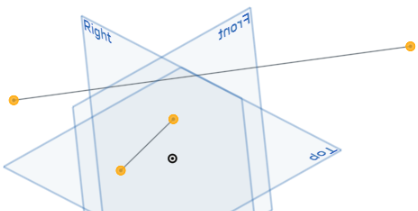

-
Click
 .
.
- Select edges (must be tangentially continuous) to create a 3D fit spline.
- Check the box to create the spline.
-
Click
 .
.
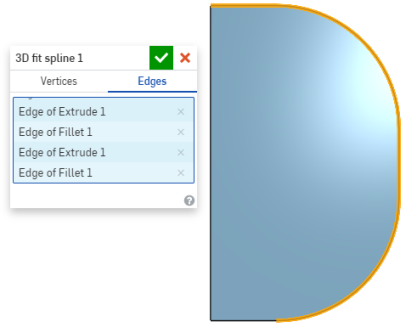
-
Click
 .
.
- Select vertices to create a 3D fit spline.
- Check the box to create a closed spline.
-
Click
 .
.


-
Click
 .
.
- Select vertices to create a 3D fit spline:
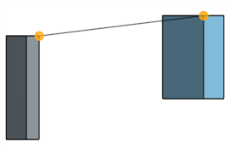
- Select Start and End directions (highlighted edges):

- Select
Match curvature at start
and
Match curvature at end:
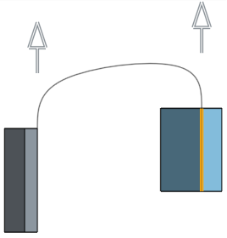
-
Click
 .
.
In addition to the surfacing tools, curves are used to create the basic building blocks of surfaces.
This lists the collection of curve feature tools. This is not an exhaustive list. Additional Feature tools may be used when manipulating curves.
- Sketch tools - Tools in the Sketch toolbar such as Line, Corner rectangle, Center point rectangle, Center point circle, 3 point circle, Tangent arc, 3 point arc, Spline, Point, and Construction used to create a sketch in a Part Studio.
-
 Helix - Create a helix using a conical or cylindrical face, single axis or z-axis of a mate connector, or circular edge.
Helix - Create a helix using a conical or cylindrical face, single axis or z-axis of a mate connector, or circular edge. -
 3D fit spline - Create a 3D fit spline through a series of vertices. Creates a curve which is listed in the Parts list under Curves.
3D fit spline - Create a 3D fit spline through a series of vertices. Creates a curve which is listed in the Parts list under Curves. -
 Projected curve - Create a curve from the projection of two sketches (Two sketches option) or from the projection of a curve on a face (Curve to face option).
Projected curve - Create a curve from the projection of two sketches (Two sketches option) or from the projection of a curve on a face (Curve to face option). -
 Bridging curve - Create a Curve connecting any two points, vertices, or Mate connectors. The resulting Curve is listed in the Feature list and the Parts list.
Bridging curve - Create a Curve connecting any two points, vertices, or Mate connectors. The resulting Curve is listed in the Feature list and the Parts list. -
 Composite curve - Represent multiple edges as one Curve. Select multiple adjacent edges, sketch entities, and other curves. Selecting non-contiguous edges may result in multiple Curves created. Selections for each Curve must meet at their vertices. (Curves are listed in the Parts > Curves list.)
Composite curve - Represent multiple edges as one Curve. Select multiple adjacent edges, sketch entities, and other curves. Selecting non-contiguous edges may result in multiple Curves created. Selections for each Curve must meet at their vertices. (Curves are listed in the Parts > Curves list.) -
 Intersection curve - Create a curve at the intersection of two or more surfaces or faces. The selections must intersect.
Intersection curve - Create a curve at the intersection of two or more surfaces or faces. The selections must intersect. -
 Trim curve - Trim or extend a curve by a distance or to a bounding entity.
Trim curve - Trim or extend a curve by a distance or to a bounding entity. -
 Isocline - Create an isocline on a sloped face. An isocline runs on a face at positions where the face has a certain slope compared to its reference definition. The resulting isocline is listed in the Feature list and Parts list.
Isocline - Create an isocline on a sloped face. An isocline runs on a face at positions where the face has a certain slope compared to its reference definition. The resulting isocline is listed in the Feature list and Parts list. -
 Offset curve - Create and extend and/or split a new curve by offsetting edges on surrounding faces.
Offset curve - Create and extend and/or split a new curve by offsetting edges on surrounding faces. -
 Isoparametric curve - Create smooth curves that run along a face or surface in the U or V direction.
Isoparametric curve - Create smooth curves that run along a face or surface in the U or V direction. -
 Edit curve - Edit an existing curve by selecting sketch entities or curves to apply a simplified approximation, elevate the degree, reposition control curve vertices and/or planarize into any 2D plane.
Edit curve - Edit an existing curve by selecting sketch entities or curves to apply a simplified approximation, elevate the degree, reposition control curve vertices and/or planarize into any 2D plane. -
 Routing curve - Create a multi-point curve across one or more planes in 3D space (routed path). This is useful for creating pipe routing, wiring, and NURBS curves for advanced surfacing.
Routing curve - Create a multi-point curve across one or more planes in 3D space (routed path). This is useful for creating pipe routing, wiring, and NURBS curves for advanced surfacing.
- Tap the 3D fit spline tool icon (
 ).
).
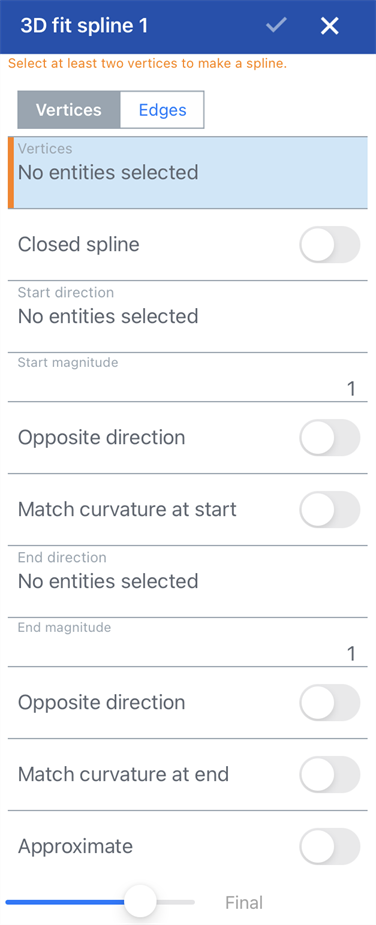
- Tap to select whether to use vertices, or edges at the top of the dialog.
- For splines using vertices:
- Tap to select vertices along which to create the 3D fit spline.
- Optionally, check the box to create a closed spline.
- If the spline is not closed, you have the option to click a line or a Mate connector (implicit or explicit) to select a Start direction.
- Enter a value or drag the directional arrow in the graphics area to adjust the Start magnitude.
- Optionally, select Match curvature at start to match the curvature of the edge or face selected as the start direction.
- Optionally, select a line or Mate connector (implicit or explicit) to select an end direction.
- Enter a value or drag the directional arrow in the graphics area to adjust the End magnitude.
- Optionally, select Match curvature at end to match the curvature of the edge or face selected as the end direction.
- For splines using edges, select tangentially continuous edges with which to create the 3D fit spline.
- For splines using vertices:
- Tap the checkmark.
A curve is created, listed under Curves in the Parts list. You are unable to show/hide the 3D Fit Spline feature; use the show/hide functionality in the Curves (Parts) list instead.

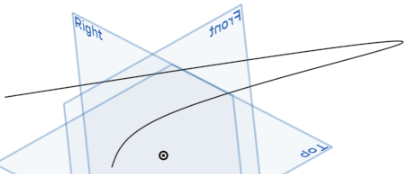
- Tap the 3D fit spline tool icon (
 ).
). - Select vertices to create a 3d fit spline.
- Check the box to create a closed spline.
- Tap the checkmark.


- Tap the 3D fit spline tool.


- Tap to select whether to use vertices, or edges at the top of the dialog.
- For splines using vertices:
- Tap to select vertices along which to create the 3D fit spline.
- Optionally, check the box to create a closed spline.
- If the spline is not closed, you have the option to click a line or a Mate connector (implicit or explicit) to select a Start direction.
- Enter a value or drag the directional arrow in the graphics area to adjust the Start magnitude.
- Optionally, select Match curvature at start to match the curvature of the edge or face selected as the start direction.
- Optionally, select a line or Mate connector (implicit or explicit) to select an end direction.
- Enter a value or drag the directional arrow in the graphics area to adjust the End magnitude.
- Optionally, select Match curvature at end to match the curvature of the edge or face selected as the end direction.
- For splines using edges, select tangentially continuous edges with which to create the 3D fit spline.
- For splines using vertices:
- Tap the checkmark.
A curve is created, listed under Curves in the Parts list. You are unable to show/hide the 3D Fit Spline feature; use the show/hide functionality in the Curves (Parts) list instead.


- Tap the 3D fit spline tool.

- Select vertices to create a 3d fit spline.
- Check the box to create a closed spline.
- Tap the checkmark.
